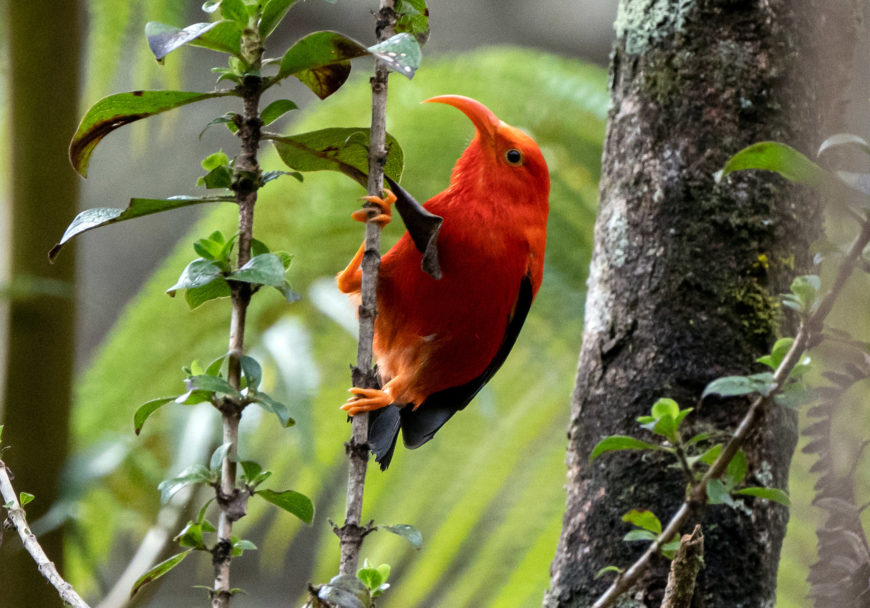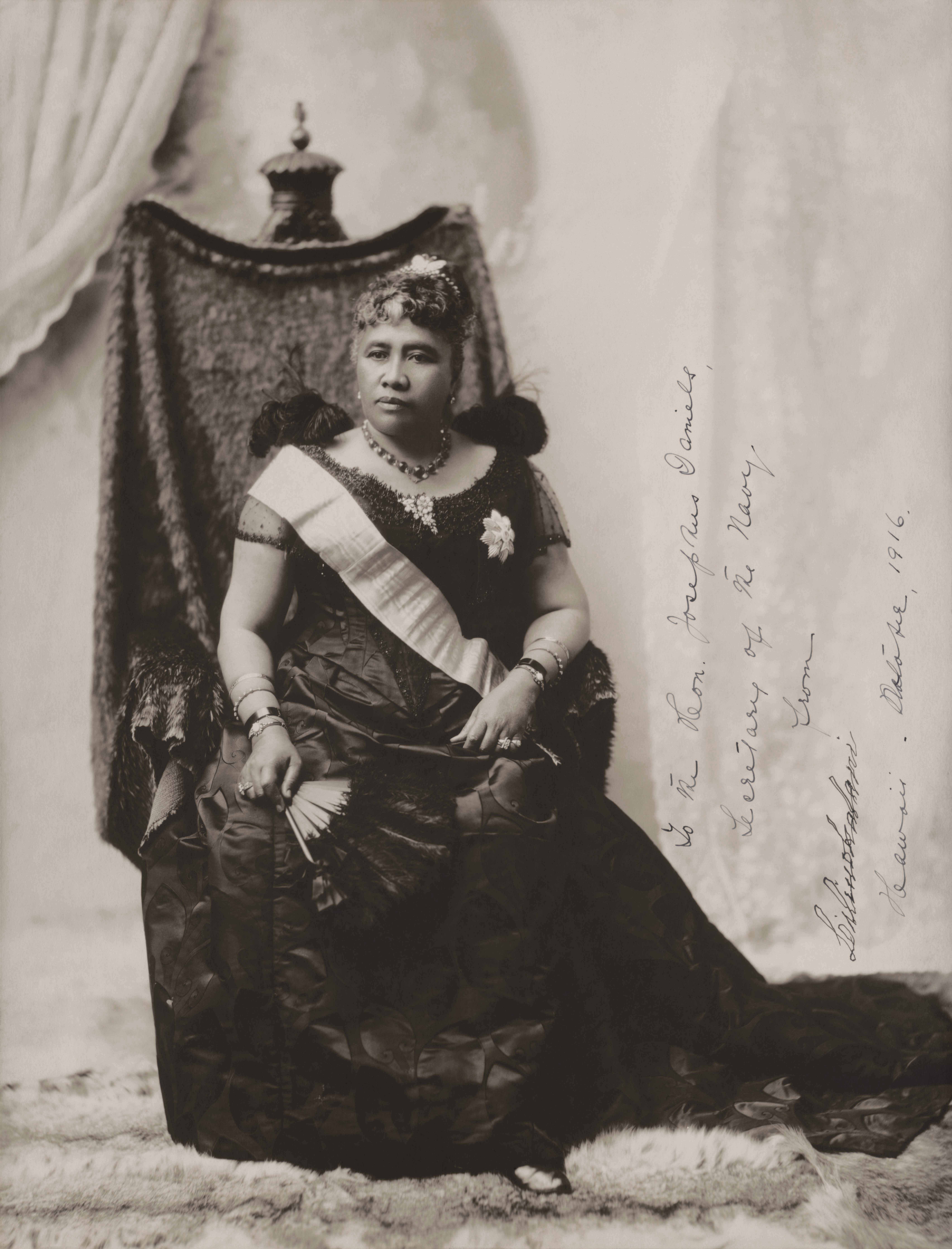
Queen Liliʻuokalani, the last sovereign of the of the Kalākaua Dynasty, c. 1891, gelatin silver print, sheet 38 x 29 cm (Library of Congress)
The Queen’s accession photograph
On January 29, 1891, the USS Charleston appeared in Honolulu Harbor on Oʻahu and quickly dispatched a message to the shore, informing Liliʻuokalani, then acting as regent during her brother King Kalākaua’s absence, that the king was dead. The Charleston had brought his body home from California. That afternoon, Liliʻuokalani would ascend to the throne as Hawaiʻi’s new queen. She was stepping into this role with her power and authority already under threat by a white male oligarchy that had steadily been chipping away at Hawaiian sovereignty throughout her brother’s reign. [1] Reflecting upon this moment seven years later, Liliʻuokalani said, “I was so overcome by the death of my dear brother, so dazed with the suddenness of the news which had come upon us in a moment, that I hardly realized what was going on about me, nor did I at all appreciate for the moment my situation.” [2] This moment would be commemorated in both words and images, including an accession photograph showing Queen Liliʻuokalani seated in state. This photograph presents Liliʻuokalani as regal and confident, and dressed in royal finery. It was tied to Hawaiʻi’s international relations, representing the monarchy’s sovereign right to rule for local and global audiences. This was particularly important given European and American interests in gaining political and economic control over the kingdom because of its strategic location in the Pacific.
Photography in the Pacific Islands was often used to objectify and other Indigenous peoples in encounters with media that was typically controlled and defined by Euro-Americans and their visual traditions. Photography in the 1890s was not commonly seen as a mobile technology that was creatively integrated into Indigenous cultures. While this is true in many circumstances it is not the case in Hawaiʻi, especially during the nineteenth century. By mid-century, the demand for photography was so high that studios and galleries known as na hale paʻi kiʻi or “houses of photography” were prevalent throughout the island chain. References to photographic media were also common in Hawaiian language newspapers, which likened photography to a “good catch of fish,” suggesting connections between material wealth, good fortune, and photography. [3] The metaphoric link between photography and fish in a popular Hawaiian language news source indicates the widespread social, cultural, and political interests Indigenous Hawaiians had for this media. Queen Liliʻuokalani’s accession photograph can be considered a conduit for such interests on both the local and global levels.
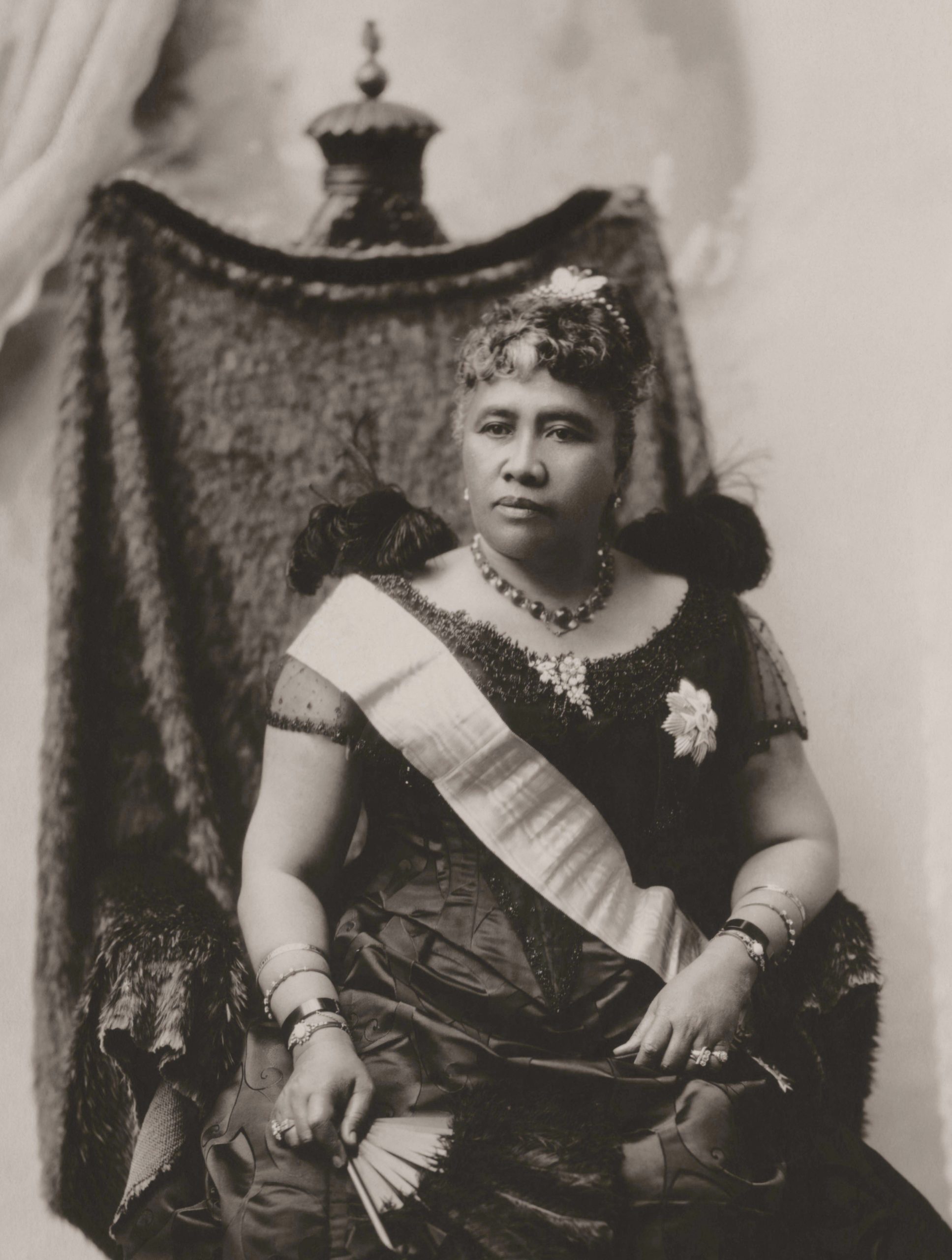
Queen Liliʻuokalani, the last sovereign of the of the Kalākaua Dynasty (detail), c. 1891, gelatin silver print, sheet 38 x 29 cm (Library of Congress)
The politics of the picture
Taken in 1891 using the popular silver-gelatin printing photographic process (likely with a glass negative, as film negatives were not in wide circulation and use until the twentieth century), the photograph shows Queen Liliʻuokalani ornamented in jewels and wearing a gown embroidered with seed beads and a sash crossing her body. The royal order of Kalākaua I is notably displayed: it is a Maltese cross, with a Kāhili or royal staff at the center, and is encircled by an inscription that reads “Kalākaua February 12 1874.” Four bracelets encircle each of her arms.
The warm tones of this image may be the unintended effect of age or the result of warm tone gelatin-silver paper. In either case, the tonal qualities render prominent contrasting textures such as the feathers of the fan that she holds and the luminous folds of her dress. Close scrutiny of her gown reveals delicate swirling volutes that combine to make a plant leaf pattern, recalling Hawaiʻi’s native flora. A jeweled flower broach emerges from a delicate patch of beadwork at her neckline. The throne on which she sits is draped in a feather cloak while her feet rest on a large fur rug.
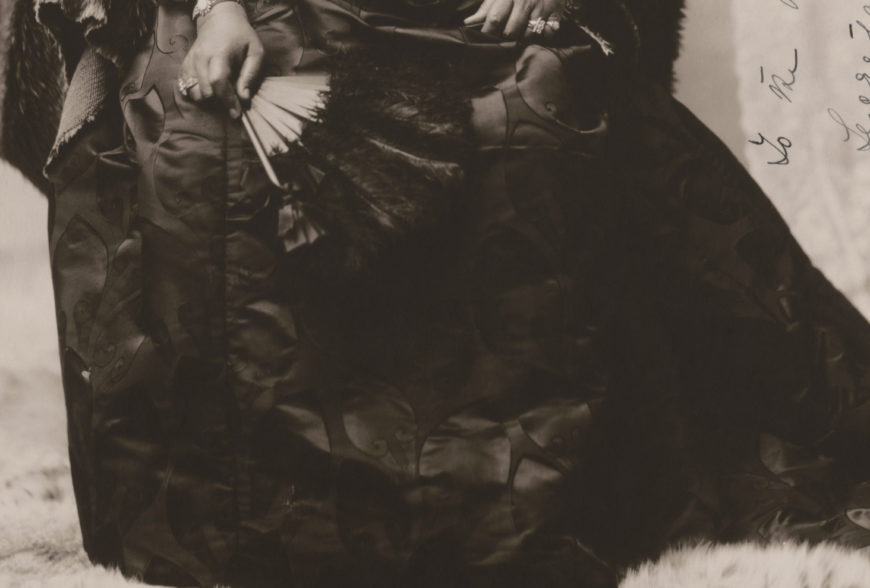
Queen Liliʻuokalani, the last sovereign of the of the Kalākaua Dynasty (detail), c. 1891, gelatin silver print, sheet 38 x 29 cm (Library of Congress)
Like many other Hawaiian artistic expressions, Liliʻuokalani’s accession photograph is rich in metaphor and layers of meaning, indicative of potent connections between the Queen as sovereign, her ʻāina (land), and place. For example, the decorative pattern on the Queen’s gown is reminiscent of taro leaves. Taro is an important food staple in Hawaiʻi. Its cultivation was threatened by colonial water management.
The feather cloak draped across the throne is another object in the photograph with significant connections to place. Feathers, and featherwork objects including necklaces known as lei, royal staffs (kāhili), and cloaks materially manifested the link between local birds like the ʻiʻiwi and mamo, and the power and authority of Hawaiian elites. Objects like these were worn or displayed at important political events. [4] These featherwork objects were of social, political and religious importance.
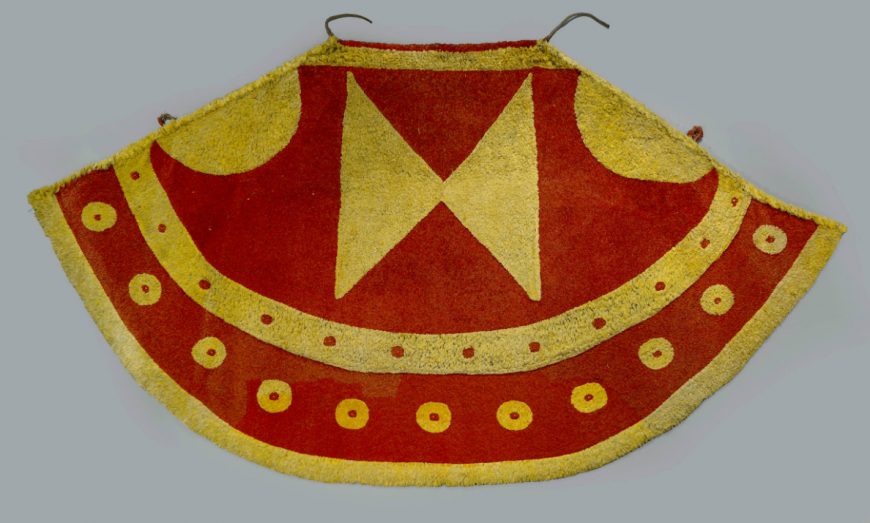
Feather cape, probably before 1850 C.E., olona fibre, feather, 68.5 x 45 cm, Hawaii (© Trustees of the British Museum)
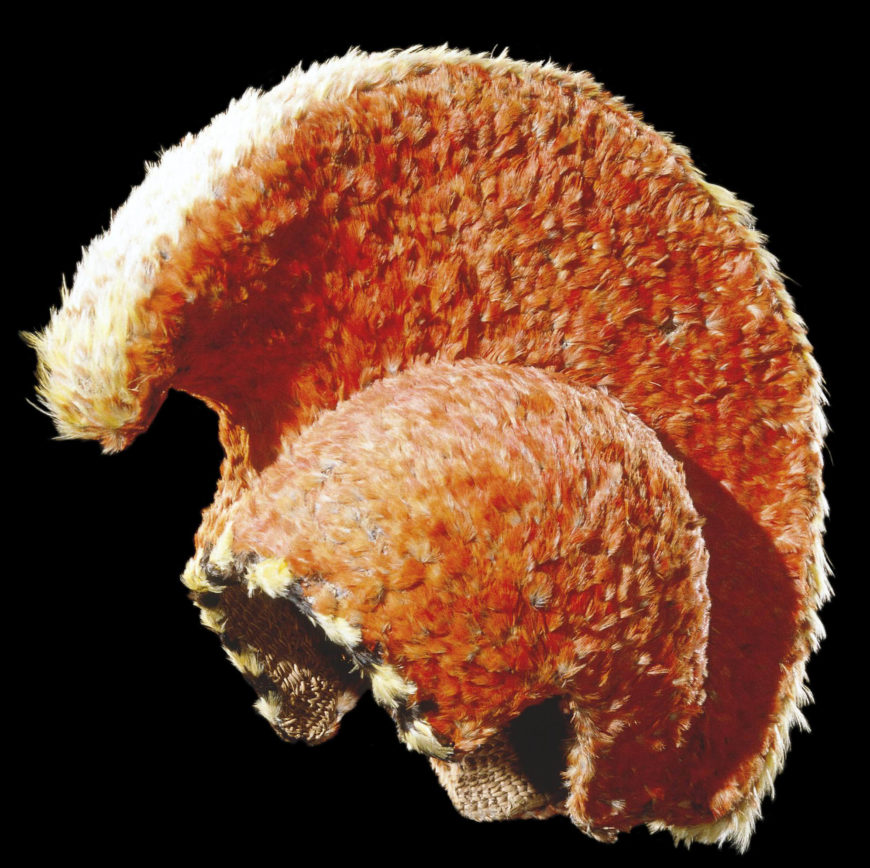
Mahiole (helmet), 18th century, vine, olona fiber, iiwi feather, honeyeater feather (Common amakihi), o’o feather, mamo, Hawaii (© Trustees of the British Museum)
Their display at events and in spaces of importance drew on older Hawaiian artistic traditions and practices. Prior to the nineteenth century, Hawaiian artisans produced large feathered sculptures representing specific deities and feathered helmets worn by chiefly men at important political and religious events. The appearance of the featherwork cloak in the accession photograph foregrounds the Queen’s sacred status and places it within the same artistic lineage of visual expressions of power and prestige—in this case in the form of objects of state, such as the mahiole (feathered helmets) from Hawaii. As such, we can read the inclusion of these objects in the photograph as a pointed statement about Queen Liliʻuokalani’s authority.
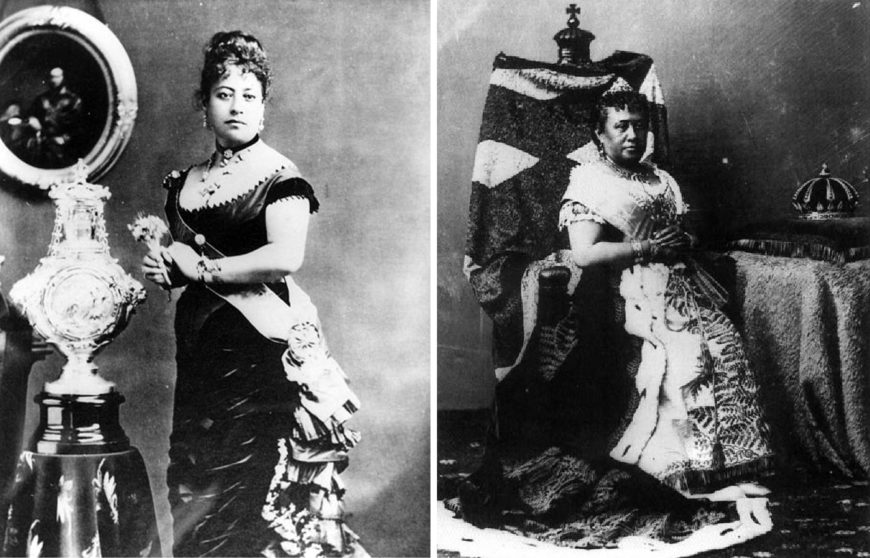
Left: Queen Emma with the silver christening font for her son Albert Kamehameha, a gift from Queen Victoria, c. 1880, photographer A. A. Montano (Hawaiʻi State Archives); right: Queen Kapiolani, c. 1883, photographer J. J Williams (Hawaiʻi State Archives)
Rather than being an anomaly in nineteenth century Hawaiʻi, the Queen’s accession photograph also stands as one prominent example among many, of Hawaiian royalty using photography to create images that promoted Hawaiian sovereignty and self-determination. Other notable examples including a photograph of Queen Emma with a silver christening cup and Queen Kapiolani’s coronation photograph. Cultivating public images like these photographs directly refuted colonial narratives that presented Indigenous Hawaiians as childlike and stuck in the past. These photographic portraits became part of the royal family’s strategy for advancing the interests of the Hawaiian people and maintaining sovereignty. Photography became coupled to Hawaiʻi’s national and international interests, allowing for creative combinations between Indigenous visual forms and newly encountered ones.

Queen Liliʻuokalani, the last sovereign of the of the Kalākaua Dynasty, c. 1891, gelatin silver print, sheet 38 x 29 cm (Library of Congress)
Accession imagery, and power in the Kingdom of Hawaiʻi
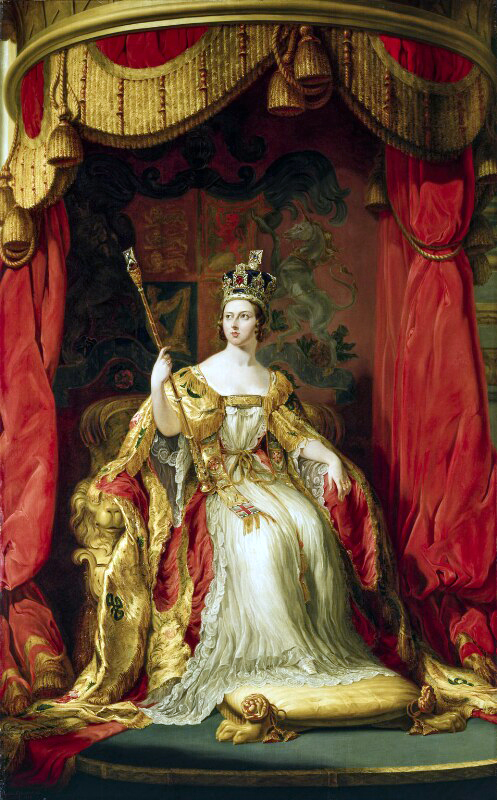
Queen Victoria, replica by Sir George Hayter (based on a work from 1838), 1863, oil on canvas, 285 x 179 cm (National Portrait Gallery)
Liliʻuokalaniʻs accession photograph derives some of its power by drawing on coronation or accession images common to European monarchies, though it does so in a uniquely Hawaiian way. Such images (both painted and photographed) present the monarch enthroned, bearing symbols of their state power and authority. In Queen Liliʻuokalani’s accession photograph this was accomplished by adopting the posture and style common in portraits and photographs of European aristocrats and through careful curation of the mise-en-scène (a stage set that tells a story). [5] For example, Queen Liliʻuokalani’s is posed frontally, her head angled to the left and as she gazes out past the photograph’s frame, a posture that is similar to the one found in the coronation painting by George Hayter of Queen Victoria of England. As with Victoria, Liliʻuokalani is opulently adorned, the folds of her dress, the cloak at her back, and fur rug on the ground blurring the boundaries between her body and the throne and providing her figure with an increased appearance of solidity and strength. Finally, Queen Liliʻuokalani also appears with several objects of state, including the royal order of Kalākaua I and the featherwork cloak.
The features of this photograph constitute far more than fashionable tailored choices. They are material expressions of Queen Liliʻuokalani’s royal authority and responsibility to her people and land. [6] This visual statement is crucial given that two years later, on January 17, 1893, Queen Liliʻuokalani’s reign would end in a successful coup by foreigners, including Sanford B. Dole, a prominent descendant of American missionaries and cousin to James Dole (the founder of Dole Food Company).
Kūpaʻa ma hope o ka ʻāina (ever loyal to the land) [7]
Far from being an ending, the overthrow of the Hawaiian monarchy in 1893 would mark a new phase of advocacy on the part of Queen Liliʻuokalani to restore control of her homeland from U.S. settlers to the Hawaiian people. Her accession image would help to shape these efforts and be shaped by them. For example, in 1916, twenty-three years after the overthrow of the Hawaiian monarchy and eighteen years after Hawaiʻi was officially annexed to the United States, Queen Liliʻuokalani gave a copy of this photograph to Joseph Daniels, then U.S. Naval Secretary. The timing and chosen gift are apt; Liliʻuokalani certainly had dozens of other photographs of herself to choose from but settled on an image that reaffirmed her unrelinquished right to rule, a message that pervades everything within the photo from the choice of medium and composition to the display of material wealth. Her legacy continues today with the accession photograph taking on renewed potency and finding new life in contemporary art, on items of popular culture such as t-shirts, and within spaces like the 2020 Onipaʻa Peace March and protests against the Ten Meter Telescope. In one 21st-century re-interpretation of this photograph by the mural artists Estria Miyashiro and John ʻPrimeʻ Hina, they explicitly draw connections between the Queen and land, with her throne transforming into the landscape itself, complete with terraced loʻi kalo (taro patch).

